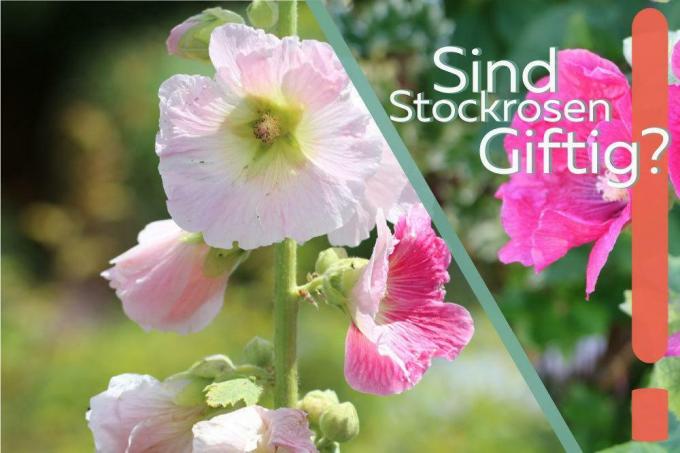
table of contents
- Hollyhocks
- Likelihood of confusion
- ingredients
- Medicinal plant
- Effect on animals
The hollyhock is a popular ornamental plant that is a welcome guest in the garden due to its upright growth and the arrangement of the flowers. Over the centuries, hollyhocks have become more and more common in Central Europe and are often cultivated due to their abundance of flowers. Because of its popularity, parents and pet owners are increasingly asking themselves whether the mallow plant is poisonous for children and pets. The result will definitely surprise you.
Hollyhocks
Likelihood of confusion
First of all: No, hollyhocks are not poisonous and can safely be kept in the garden without the risk of possible poisoning. With the hollyhocks (bot. Alcea) is a genus within the mallow family. It is not in itself a real rose, but is called that only because of its flower shape. Real roses (bot. Rosa) are not poisonous and are even used in the kitchen.
The following "roses" are poisonous for humans and animals:
- Peonies (bot. Paeonia)
- Snow rose (bot. Helleborus niger)
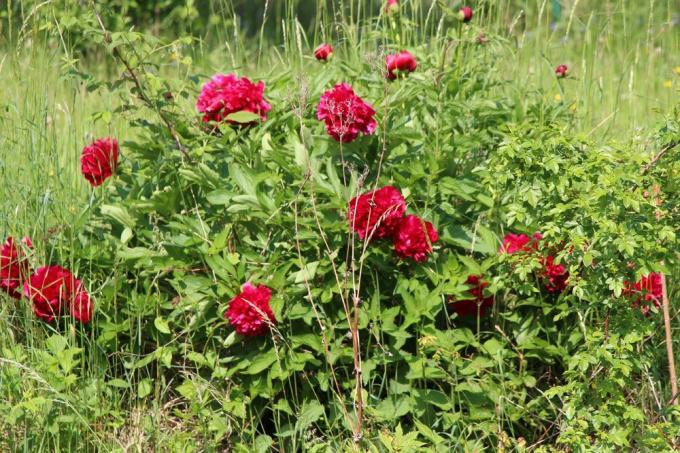
One advantage: peony, snow and hollyhocks are so different in terms of their morphological features that they can be easily distinguished. There is a higher risk when wild hollyhocks with the highly poisonous thimbles (bot. Digitalis).
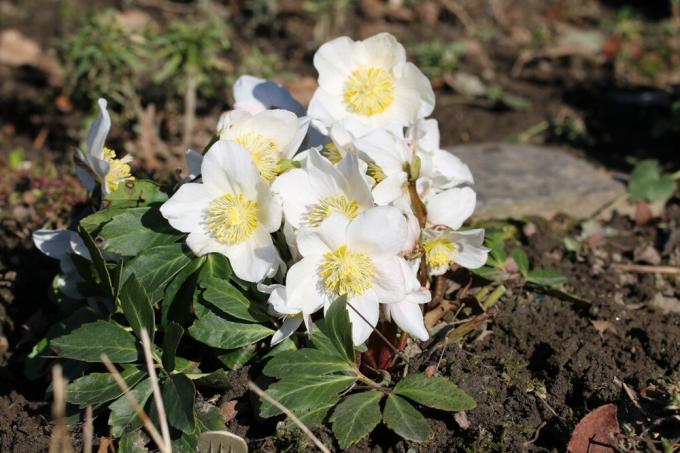
The reasons for this are:
- Growth habit
- Flower colors
- Arrangement of flowers
Since both plants are upright and the flowers grow around the main stem, overgrown plants in particular can confuse children or pets. For example, if you have hollyhocks in the garden and your children are used to picking them or putting them in their mouths, thimbles can be life-threatening. Although the two genera differ considerably from each other, this confusion can occur especially in the forest. Fortunately, hollyhocks are mostly found in gardens, parks and avenues and less as an overgrown plant. However, be careful as the flower colors are very similar.
ingredients
The hollyhocks, especially the common hollyhock (bot. Alcea rosea), have a large number of ingredients that are non-toxic to humans. As mentioned above, the hollyhock is not poisonous and can even be used for a variety of uses. Before doing this, however, you should take a closer look at the individual ingredients in order to get an overview of the hollyhock.
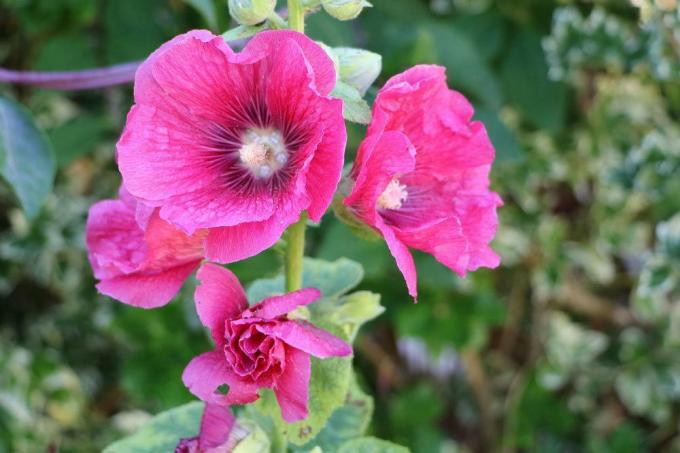
Malvidin
Malvidin is the main coloring in the plant and belongs to the group of anthocyanins. These substances are developed by an extremely large number of plants and ensure the numerous colors in the red, blue and purple spectrum that are primarily found in hollyhocks. Malvidin is a special dye that is also found in red wine and is responsible for the intense coloring. The pH of the plant determines which color is used. For example, red hollyhocks have a pH below 4.
Mucilage
Mucilages are formed by numerous plants and other organisms and act as natural protection and water storage. The mucilage in hollyhocks is not toxic and is used in home medicine because it has a positive effect on people. These are polysaccharides, certain carbohydrates. The mucous membranes in particular benefit from the mucous substances and ensure that they are no longer irritated and can relax.
Tannic acid
These substances are defense mechanisms of plants, which are reflected in the bitter taste of the individual plant parts. They are known as tannins and, for example, determine the quality of a wine. Only a few animals like to eat these bitter substances and therefore the hollyhock can protect itself from predators. Tannins are the only substances in hollyhocks that could have a slightly unpleasant effect on the body. Flatulence or a stuffy stomach can result, but only if very large amounts of the plant have been consumed. Therefore, children should not consume too many plant parts of the hollyhocks.
Essential oils
Essential oils provide the aroma and scent of the mallow family. These can be put together in a very complicated way and thus ensure the unmistakable smell of the hollyhocks. In addition, the essential oils together with the mucilage have a positive effect on health.
Medicinal plant
Effect as a medicinal plant
Since the hollyhock is not poisonous, it has been used in medicinal medicine for centuries. When properly prepared, the ingredients have positive effects on your body and can help with a variety of ailments. The entire plant, from the roots to the flowers, is used for this, which makes the hollyhocks an absolute highlight in your garden. It is mainly drunk as a tea and can even be used as a mouthwash, for example if your mouth is inflamed.
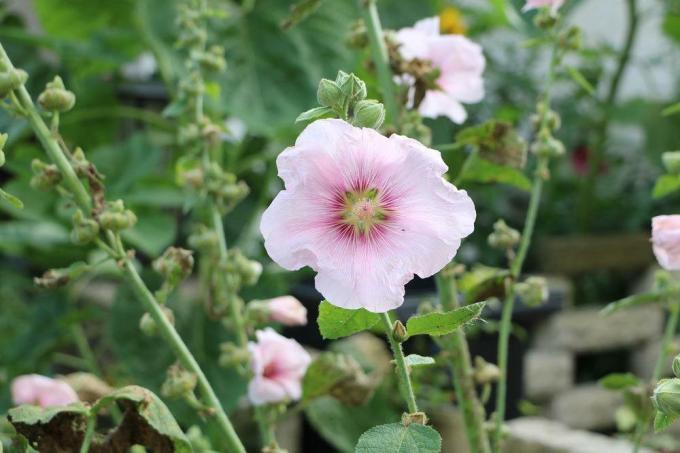
The other areas of application are:
- cough
- Loss of appetite
- Inflammation of the throat, throat, vocal cords, stomach, skin and intestines
- gripal infect
- bronchitis
- fever
- diarrhea
- works against ulcers
- works against burns
- White flow and menstrual disorders
- Eczema
- Wounds
Even large amounts of the tea, infusion or compresses with the plant are not poisonous and can therefore be used without hesitation. Even baths with the infusion of flowers can be implemented, which has a very good effect on the body. Washing is possible in the same way. Hollyhocks are typically used as a mucus drug, as their mucus, together with the essential oils, has a pleasant effect on the throat. In addition, the complexion can be improved later if tea or compresses are used regularly. In addition to the health problems mentioned above, it also works in the following ways.
- softening
- diuretic
- antispasmodic
As a precaution, babies and toddlers should refrain from consuming the plant parts of the hollyhock. This is purely a precautionary measure, because the individual parts of the plant represent a risk of swallowing due to their size. You can play with it, because even the roots do not pose a threat. The hollyhocks are therefore even good for your protégés to explore. Alcea are real all-rounders and can even be burned as a smoking material. They give off a unique, exhilarating scent.
Tip: Absolutely refrain from using or consuming the flowers and plant parts if aggressive chemical agents or even pesticides have been used to care for the ornamental plants. These are absorbed by the mallow plant and can possibly poison you and your children.

Effect on animals
Domestic and farm animals are also safe with respect to the hollyhock. The substances contained are non-toxic even for cats and small rodents. Even if your cat is notoriously chewing on every plant in your garden, hollyhock is no problem at all. Of course, the cat should avoid the plant if you have used chemical agents on the plants as described above or if they are still stuck in the ground. Then these substances could get into the animal's organism and cause unrest. Hollyhocks are even suitable as a snack for rodents and rabbits. Above all, the leaves should be used here.



